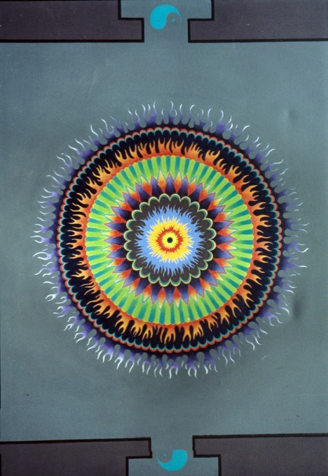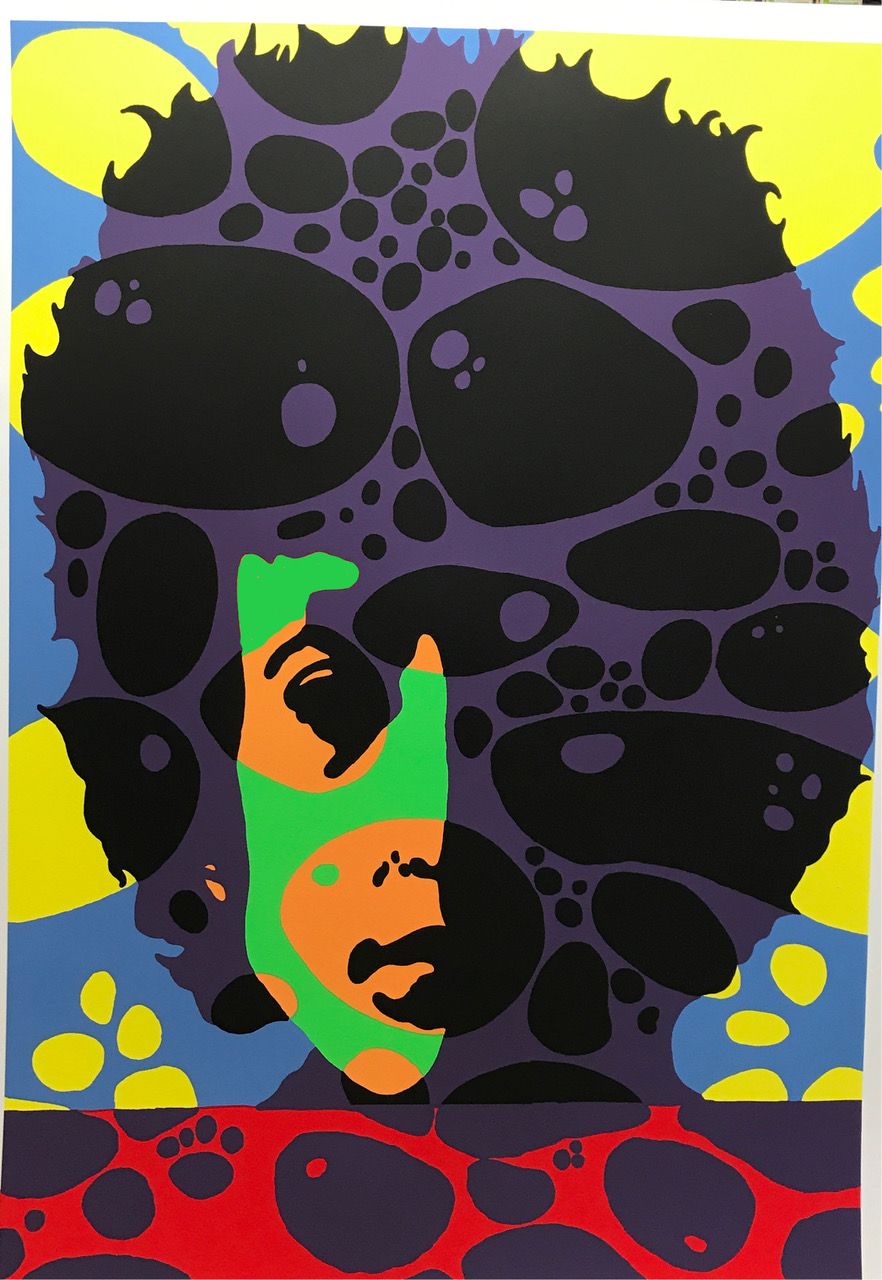I first met Larry in 1967, when he was in the dance troupe Exploding Galaxy.
They would perform free-style dance at the weekly hippie gathering, the UFO Club, in between sets by the Pink Floyd. They helped encourage everyone to ‘freak out’ their dancing style. The Exploding Galaxy were part of a commune which lived in North London and took their name from a painting by Larry of the same name. They were immortalised in the book 99 Balls Pond Road by Jill Drower, one of the communards.
Born in 1945, Larry spent much of his childhood in Baghdad, where his father Philip worked with Shell Oil. His exposure at an early age to Islamic art and architecture and its intricate geometry became a lifelong influence. Later he went to boarding school in England and then to Croydon Art College.
Larry's art owed much to his art school mentor Bridget Riley. He created more structured geometric forms than found in her work, while still generating the vibrational effect that results from staring at Riley's paintings, the 'op art' experience. Larry's paintings were more symmetrical and colourful while still achieving and even enhancing the same ‘op’ effect. His circular mandalas were an aid to meditation and awareness heightening, oscillating when you concentrated on them.
At psychedelic events such as the UFO Club, Summertime in the Wintertime or the 14-Hour Technicolor Dream, Larry's mandalas would be the focus of light shows created by John Bloomfield. The impact of the mandala was enhanced with pulsing light, increasing the op-art psychedelic effect of looking at his paintings. His mandalas were bought by Jimi Hendrix and George Harrison and funded his meals tab at the vegetarian Baba bel Poori restaurant in Bayswater.
In 1967 he married Carol Grimes, the blues and jazz singer who later performed with Lol Coxhill and the band Delivery. Their debut performance was at our macrobiotic restaurant Seed in 1969. One of Larry's mandalas adorned their album cover.
Larry produced work for Apple Corps and subsequently produced silk screen prints representing John Lennon, Frank Zappa, Jimi Hendrix and Bob Dylan.
In 1970 George Harrison invited Larry to paint murals at Friar Park, his vast mansion near Henley. Regrettably these works, completed over a year, appear to have been lost. Patti Boyd, his first wife, is unaware what happened to them. Olivia Harrison cannot remember ever seeing them.
Larry also produced landscapes with towers and minarets rising on high peaks that imagined a fantasy world reminiscent of Arabian Nights. After his break up with Carol the mood of his fantastical landscapes changed and led to a series of paintings showed crumbling edifices, with cracks in the walls and broken towers.
Larry was commissioned by the owners of country houses to capture the look of their houses in his distinctive magical realist style, populating the grounds with cricket or croquet players in Edwardian or Victorian dress. The intensity of the acrylic colors he used gave a special vibrancy to these paintings and, indeed, all of Larry's work.
He also spent some time in Granada, painting the gardens of the Alhambra.
In 1968 Larry, myself and Jordan Reynolds spent a week in Marrakech. It was a bit of a blowout for us all, partying until late and then recuperating by the hotel pool the following day. Larry was captivated by the beauty of the architecture and art of the city and the high plateau landscape of the region. He and his new wife Karen subsequently visited Marrakech frequently and Larry began to capture on canvas the fountains, palaces, gardens and mosques of the city. This was a time when the old riads of Marrakech were being restored and the new owners would commission Larry to capture the intricate tiling and designs of the courtyards and fountains of their villas. Larry's bible at this time was "Arabesques" - an art book by Jean-Marc Castera that explained in great detail the mechanics (and cheats) of, for example, creating a 128-point star and integrating it into a pattern of interlocking stars. Larry's understanding of how this art was created by the original tilers and designers was reflected in his canvases, which draw the viewers eye inwards and then back and from right to left and left to right. He saw this work from the inside out and captured its depth of geometrical and mathematical thinking in a way that an artist without that understanding would find challenging. In Tangiers he stayed with Philip Arnott, who introduced him to clients in Marrakech and who now deals art from the Lawrence-Arnott galleries in both cities.
In the late 1980s and 1990s Larry worked closely with me on a number of projects. I would brief him on a new organic food product project such as whole grain corn flakes, blue corn flakes, muesli, baked beans, Blaisdon Red plum jam or hummus tahini and he could create a painting that formed the basis for the label or carton artwork. He created a landscape of the digestive system that provided the perfect packaging for our All Your Fibre breakfast cereal.
By then Larry had settled into a pattern of spending 3 months in Marrakech, then London, then Marrakech again. He would complete commissions in his London flat for clients in Marrakech, then deliver them a few months later and obtain new work, which he would complete in Marrakech or take back to London to complete. His paintings were also sold to visitors to La Mamounia hotel, the pre-eminent and historic establishment in Marrakech where Winston Churchill often stayed and painted.
Larry was a regular visitor to our house in Hastings and painted scenes that captured in detail the shape and symmetry of the Old Town's tiled rooftops, the patterning of the wood on the boats of Hastings fishing fleet and even imposed Arabic- patterned arches over a view across the Old Town from the nearby allotments, where he mischievously slipped in a cannabis plant to a lush display of asparagus, marrows, leeks, lettuces and other garden produce.
In 2004 a work colleague showed me an advertisement in Record Collector magazine for Larry's poster of Jimi Hendrix, selling at £350. I showed it to Larry and he contacted the vendor who proposed printing a limited edition of the poster, to be signed by the artist. The posters were marketed in 2005 and are now prized collector’s items. Larry signed the limited edition but then died a few months later.
The Victoria and Albert Museum hold Larry's Jimi Hendrix silkscreen poster in their permanent collection. They used his 'Kaleidoscope Eyes' (hippie slang for acid-tripping) poster on the publicity material for their wonderful 'Revolution: Records and Rebels 1966-1970) exhibition that runs from September 2016 until February 28 2017). The revival of interest on the 50th Anniversary of the 1967 Summer of Love has increased awareness and appreciation of Larry Smart's work. Larry captured the essence of the time and his work informs any understanding of the aesthetic that reflected the transformation in social and political thinking that emerged from the experience of the late 1960s and its aftermath.
A Larry Smart limited edition A1 silk screen print, Kaleidoscope Eyes is now available - only 300 printed, please order from here.



























